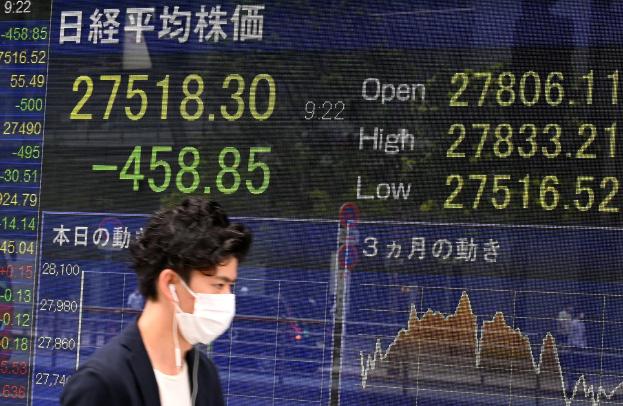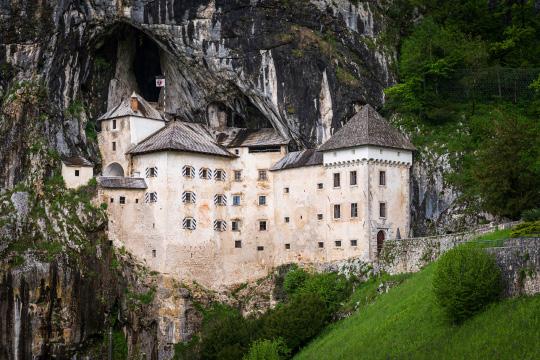
10 minute read
BIENVENIDO J. CASACLANG to the rank of Brigadier General, PAF
Japan economy rose slightly in second quarter despite COVID
Discovering Slovenia’s underground labyrinths
TOKYO, Japan—Japan’s economy grew slightly in the second quarter, recovering from a slowdown at the start of the year despite continuing virus surges and restrictions, data showed Monday.
The world’s third-largest economy contracted at the beginning of the year as a new wave of infections forced the government to impose virus restrictions that slowed consumption.
But despite continued virus worries and restrictions that have lasted most of this year, Japan’s economy grew a better-than-expected 0.3 percent in the three months to June, data from the cabinet office showed.
That slightly exceeded the expectations of economists surveyed by Bloomberg, who had forecast just 0.1 percent quarter-on-quarter growth.
The data released by the cabinet office also showed a slight upwards revision for the first quarter, when the economy shrank 0.9 percent, compared with a previous estimate of 1.0.
Japan has seen a smaller virus outbreak than many developed economies, with 15,400 deaths despite avoiding harsh lockdowns.
But for much of this year Tokyo and several other regions have been under virus states of emergency, limiting alcohol sales and restaurant and bar opening hours.
Experts have warned the measures are losing their effectiveness, with signs the rules are being increasingly flouted.
Stefan Angrick, a senior economist at Moody’s Analytics covering Japan, said consumption proved surprisingly resilient despite the restrictions.
“The Japanese economy eked out some moderate growth in the second quarter of the year, avoiding a technical recession thanks to a combination of stronger consumption and business investment,” he said in a note.
Japan is also playing catch-up with its vaccine program, which began much later and more slowly than those in many other developed economies. AFP
A man walks past an electronic quotation board displaying a share price of the Tokyo Stock Exchange in Tokyo on August 16, 2021. Japan’s economy expanded slightly in the second quarter, recovering from a slowdown at the start of the year despite continuing virus surges and restrictions. AFP
Stock market rallies; URC, Emperador lead advances
SHARE prices bounced back Monday in bargain hunting after investors pounced on stocks that were battered last week.
The Philippine Stock Exchange Index jumped 193.49 points, or 3.1 percent, to 6,513.68 on a value turnover of P8.6 billion. Gainers edged losers, 101 to 98, with 41 issues unchanged.
Emperador Inc. of tycoon Andrew Tan, the biggest liquor maker, surged 16.4 percent to P14.20, while International Container Terminal Services Inc. of magnate Enrique Razon Jr., the largest port operator, advanced 7.1 percent to P182,
Universal Robina Corp. of the Gokongwei Group, the biggest snack food maker, rose 6.1 percent to P136.90, while SM Investments Corp. of the Sy Group climbed 5.7 percent to P964.
The rest of Asian stocks were mostly down on Monday as weak Chinese economic data, fears of a resurgent coronavirus and the Taliban’s victory in Afghanistan gnawed at investor sentiment.
There were dips in Hong Kong, Sydney, Singapore, Taipei, Wellington and Jakarta, while Mumbai was up. Shanghai was up 0.03 percent at the close.
In Tokyo, the benchmark Nikkei 225 index closed down for a third consecutive session on Monday despite government data showing a 0.3 percent rise in GDP—slightly more than expected after a surge in virus infections and new restrictions.
Retail sales in China expanded 8.5 percent in July year-on-year and industrial output was up 6.4 percent, according to figures released by Beijing’s statistics bureau, with both figures below analyst estimates.
Lockdowns and other movement restrictions brought in to combat the country’s recent coronavirus outbreaks have been blamed for hampering economic performance along with a series of deadly floods.
“The spread of domestic outbreaks and natural disasters have affected the economy of some regions, and economic recovery remains unstable and uneven,” National Bureau of Statistics spokesman Fu Linghui told a press briefing.
Raymond Yeung, chief economist for Greater China at ANZ Banking Group, said the figures “suggest the economy is losing steam very fast.”
Surging infections linked to the Delta variant of the coronavirus “also adds extra risk to August’s activities,” he added.
The resurgence of the virus in China was “weighing on investors’ nerves now, especially when one looks at the evolution of outbreaks in the region from Australia to Singapore to Japan and everywhere in between,” said Jeffrey Halley, senior market analyst for Asia Pacific with OANDA. With AFP
PSEi August 16, 2021
TOP GAINERS
LAST % PRICE CHANGE CHANGE
1 TECHW 1.37 1.37 137,000% 2 LRW 0.465 0.075 19.23% 3 EMP 14.2 2 16.39% 4 MACAY 6 0.82 15.83% 5 AGI 9.75 0.75 8.33% 6 DFNN 3.92 0.28 7.69% 7 IPM 7.1 0.5 7.58% 8 MB 0.435 0.03 7.41% 9 BKR 1.34 0.09 7.20% 10 ICT 182 12 7.06%
TOP LOSERS
LAST % PRICE CHANGE CHANGE
1 ABG 6 -0.74 -10.98% 2 OV 0.011 -0.001 -8.33% 3 MA 0.011 -0.001 -8.33% 4 OPM 0.011 -0.001 -8.33% 5 PHA 1.11 -0.1 -8.26% 6 APL 0.104 -0.008 -7.14% 7 BSC 0.52 -0.03 -5.45% 8 UPM 0.0087 -0.0005 -5.43% 9 NI 1.26 -0.07 -5.26% 10 FJP 2.68 -0.13 -4.63%
MOST ACTIVE
VOLUME VALUE (PHP)
1 ACEN 59449000 544516037 2 CNVRG 16272500 437743515 3 EMP 24968200 341621740 4 ALI 9794600 320741700 5 URC 1810080 245619780 6 DMC 40429800 244527370 7 MONDE 14681300 232083180 8 SM 233770 223904355 9 SMPH 5582300 184798745 10 GLO 76155 152586135
By Bojan Kavcic
ORLEK, Slovenia—The grass flickered gently above a crack in the limestone and Ludvik Husu instinctively knew he had found what he was searching for: a new cave in Slovenia’s dramatic Karst region.
The seasoned cave enthusiast, with more than 50 years’ experience, told AFP that “the conditions were perfect... all the signs pointed to something beneath” as he felt the air current push up from below.
The 63-year-old had come across a new, 60-meter (196-foot) deep limestone cave, a discovery that made the headlines this summer in a country that prides itself in its 14,000 underground grottoes.
The tiny Alpine nation is unusually rich in caves, which are a major tourist attraction. One even houses an entire castle and another was used by the European Space Agency to help train astronauts.
Biological treasure trove
Perhaps best known is the Postojna cave system, the longest in Europe, unearthed by another amateur enthusiast two centuries ago.
When local lamplighter Luka Cec decided to explore a hidden crack while scouting out the Postojna area for a visit by Austrian Emperor Franz, he is reputed to have said that he had stumbled on “a new world... a paradise!”
The Postojna system extends for 24 kilometers (15 miles) and has offered up valuable finds for biologists.
Stanislav Glazar, a Postojna cave guide and speleology enthusiast, told AFP that more than 150 species have been discovered in the system.
Among them is the Proteus anguinus or “little dragon,” an ancient aquatic salamander that can live up to 100 years and was previously considered living proof that dragons had once existed.
A cave-dwelling beetle-–the slender neck beetle or Leptodirus hochenwartii—was also found here, reputedly by Cec.
Glazar sid Postojna is one of the richest caves in the world “in limestone formations, with a dense concentration of stalactites, columns, pillars.”
The cave, situated some 50 kilometers south of the capital Ljubljana, was also home to the world’s first cave tourist train, which began transporting visitors in 1872. cave systems are of historical, cultural and even extraterrestrial interest.
The dramatic, medieval Predjama castle was built in a cave mouth to make access difficult and to provide an escape route through a shaft in the rock face.
The Vilenica cave, which Slovenes have been exploring since 1633, is known for the annual eponymous literary prize awarded in its interior.
And the UNESCO-listed Skocjan system was where the European Space Agency sent some astronauts to prepare for life in space.
“Astronauts know that the Karst world is exceptional, in a similar way to the environment in space: you don’t know what to expect at your next step,” said Skocjan Caves supervisor Tomaz Zorman.
But for Husu, it’s the hunt which proves most rewarding.
The “ideal time for cave searching is the winter” when the air above ground is cooler than that in the caves.
Once he knows there is something beneath, he digs around the crack to widen it and alerts fellow cavers to help gain access.
He then uses ropes and a lamp to descend into what are vertical entrances in most caves, known as “chimneys.” AFP

Thailand downgrades 2021 outlook on rising infections
BANGKOK, Thailand—Thailand downgraded its economic growth forecast for 2021 on Monday as it battles its worst COVID-19 wave, which has brought record numbers of new infections and deaths.
The kingdom last year suffered its worst full-year performance since the Asian financial crisis of 1997 with a 6.1-percent economic contraction.
The Office of the National Economic and Social Development Council (NESDC) had initially given a cool forecast for recovery during the first quarter, estimating growth of 1.5 to 2.5 percent for 2021.
But on Monday, NESDC secretary general Danucha Pichayanan announced it had to revise that figure down to between 0.7 and 1.2 percent.
“This crisis caused by the pandemic is unlike the financial crises of 1997 and 2009—our estimation is based on domestic causes,” he said during a press conference.
He added that the new forecast was dependent on the hope that the pandemic’s curve will flatten after the third quarter, thus enabling a relaxation of restrictions by October.
“But if the pandemic continues and relaxation cannot start in the fourth quarter... the growth could be lower than 0.7 percent,” Danucha said.
Thailand’s GDP for the second quarter was up 7.5 percent on the same period last year, the first sign of recovery since the pandemic.
The growth was most visible in agricultural, industrial and exports sectors, while tourism—once Thailand’s cash cow—remained sluggish.
Since the start of the pandemic Thailand has recorded 928,314 cases with 7,733 deaths, the bulk of them detected since April.
The country has seen more than 20,000 new cases reported daily for nearly a week, crowding its alreadyhampered healthcare system and filling up its state-run quarantine facilities.
AFP
China’s retail sales slip as virus spikes
BEIJING, China—Growth in China’s retail sales and industrial production slowed in July, official data showed Monday, with a rebound of COVID-19 dragging on demand while recent floods disrupted businesses.
The world’s second-largest economy staged a rapid recovery from last year’s coronavirus outbreak, beating back the virus with mass testing and strict lockdowns.
But a flare-up across the country due to the Delta variant has threatened the good news on growth with renewed localized lockdowns and extensive travel restrictions.
Retail sales rose 8.5 percent on-year in July, the National Bureau of Statistics said on Monday, below a Bloomberg consensus forecast of analysts.
This figure was also below 12.1 percent growth in June, likely reflecting the virus resurgence in dozens of places last month, according to analysts.
“The spread of domestic outbreaks and natural disasters have affected the economy of some regions, and economic recovery remains unstable and uneven,” NBS spokesman Fu Linghui told a press briefing on Monday.
Industrial production rose 6.4 percent in July, easing as well from the month prior, the NBS said.
China’s urban unemployment rate, meanwhile, ticked up to 5.1 percent.
Iris Pang, ING’s chief economist for Greater China, told AFP industrial output was weak “because of the semiconductor chip shortage that has affected production.”
A shortage of chips has been sending shock waves through the global economy, squeezing supplies of everything from cars to headphones. AFP






